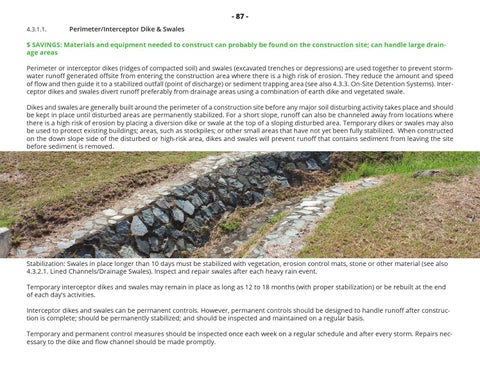- 87 4.3.1.1.
Perimeter/Interceptor Dike & Swales
$ SAVINGS: Materials and equipment needed to construct can probably be found on the construction site; can handle large drainage areas Perimeter or interceptor dikes (ridges of compacted soil) and swales (excavated trenches or depressions) are used together to prevent stormwater runoff generated offsite from entering the construction area where there is a high risk of erosion. They reduce the amount and speed of flow and then guide it to a stabilized outfall (point of discharge) or sediment trapping area (see also 4.3.3. On-Site Detention Systems). Interceptor dikes and swales divert runoff preferably from drainage areas using a combination of earth dike and vegetated swale. Dikes and swales are generally built around the perimeter of a construction site before any major soil disturbing activity takes place and should be kept in place until disturbed areas are permanently stabilized. For a short slope, runoff can also be channeled away from locations where there is a high risk of erosion by placing a diversion dike or swale at the top of a sloping disturbed area. Temporary dikes or swales may also be used to protect existing buildings; areas, such as stockpiles; or other small areas that have not yet been fully stabilized. When constructed on the down slope side of the disturbed or high-risk area, dikes and swales will prevent runoff that contains sediment from leaving the site before sediment is removed.
Stabilization: Swales in place longer than 10 days must be stabilized with vegetation, erosion control mats, stone or other material (see also 4.3.2.1. Lined Channels/Drainage Swales). Inspect and repair swales after each heavy rain event. Temporary interceptor dikes and swales may remain in place as long as 12 to 18 months (with proper stabilization) or be rebuilt at the end of each day’s activities. Interceptor dikes and swales can be permanent controls. However, permanent controls should be designed to handle runoff after construction is complete; should be permanently stabilized; and should be inspected and maintained on a regular basis. Temporary and permanent control measures should be inspected once each week on a regular schedule and after every storm. Repairs necessary to the dike and flow channel should be made promptly.
